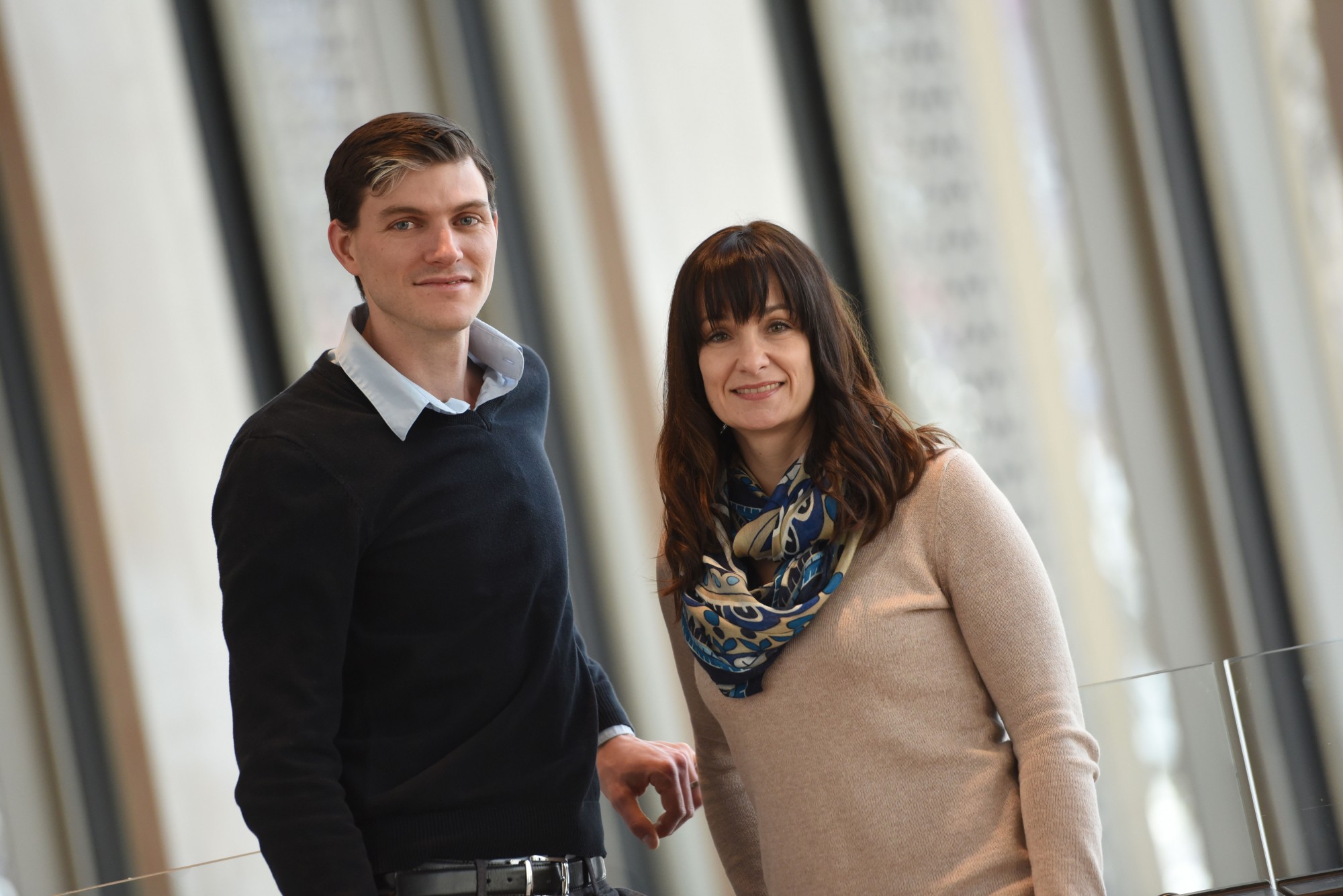 Phil McKay BEng ’07, MASc ’11, and Brandy Giannetta BA ’98, MA ’99, champion wind energy growth nationwide in their roles at the Canadian Wind Energy Association (CanWEA).
Phil McKay BEng ’07, MASc ’11, and Brandy Giannetta BA ’98, MA ’99, champion wind energy growth nationwide in their roles at the Canadian Wind Energy Association (CanWEA).
Two University of Windsor alumni at the forefront of Canada’s wind energy industry hope to drive economic and social change that will assist the country in its transition to a low-carbon economy.
“You’ll never run out of wind. Not only is the resource infinite, it’s free,” says Brandy Giannetta BA ’98, MA ’99. “Wind energy is now the lowest-cost option for new electricity generation in Canada, and it can be deployed incrementally and quickly.”
Giannetta and fellow alumnus Phil McKay BEng ’07, MASc ’11 champion wind energy growth nationwide in their roles at the Canadian Wind Energy Association (CanWEA), a non-profit industry association that represents the wind energy industry. CanWEA’s members are involved in the development and application of wind energy technology, products and services.
For the last six years, Giannetta has worked with original equipment manufacturers, wind project developers, owners, operators and service providers as CanWEA’s Ontario regional director.
“I always felt strongly about supporting industry and advocating on behalf of a bigger picture,” says Giannetta, who also serves on the Advisory Board of Women in Renewable Energy. “I’ve met so many people who are passionate about what they do and are environmentally conscious but also business driven focused. They lead research to drive their mandate and I just loved everything about what they stood for.”
Giannetta says wind turbines are not always accepted in communities. She’s worked hard to develop best practices in community engagement and make a case for existing fleets, ensuring they are maximized.
“You can farm right up to the base of a wind turbine. This enables farmers to remain on the land, hedge against low- yield crop years and stabilize or increase earning potential.”
Giannetta left the University of Ottawa in 1996 to finish her Bachelor of Arts degree at the University of Windsor. She said the course offerings, smaller class sizes and hands-on teaching methods led her to Windsor’s political science program and subsequent Master of Arts degree.
She fondly recalls class debates and discussions led by political science professor Dr. Howard Pawley, who served as Premier of Manitoba from 1981 to 1988 and Dr. Lloyd Brown-John who served as her thesis supervisor for her MA. Through her UWindsor connections, she landed an internship at the Ontario legislature, which led to a 10-year stint as a political staffer and manager at one of Canada’s largest eco-energy firms, administering Natural Resources Canada’s Retrofit for Homes Program and the Ontario Home Energy Savings Program.
Like Giannetta, McKay’s university experience helped him secure a job right out of school. The mechanical engineering graduate started his career as a design and release engineer and later an engineering supervisor at Roush Industries in Michigan. He spent years designing and testing thermal management systems for performance cars like the Ford GT350 and innovative start-ups.
“My passion going into Detroit in the first place was driven by a few classes that I had taken on electrical motors and fuel cell systems,” says McKay. “Environmental sustainability has always been a passion of mine and I wanted to get behind unique electric car projects.”
Although McKay did get to contribute to electrification projects, he says “they were very concept driven. More of a showpiece rather than a viable solution for market. “I realized that, especially seeing wind turbines going in along the 401, it didn’t matter at that time, sustainability wise, if you were driving electric or gas cars. I wanted to be a part of the solution upstream — renewable energy.”
And so, McKay walked away from the automotive sector to pursue his clean energy dream by testing wind turbines on Prince Edward Island. Now, as CanWEA’s operations and maintenance program director, McKay works with industry to advance wind farm safety, performance and power grid contributions.
He still collaborates with UWindsor’s Dr. Rupp Carriveau BASc ’94, the civil engineering professor who supervised his Master of Applied Science thesis in Group Dynamics of Commercial Scale Wind Turbines.
“I’ve never felt like my time at the University of Windsor was over,” says McKay. “I continue to talk to Rupp and Dr. David Ting and continue to be engaged in work because they really are at the forefront. All these relationships you build and connections you make are launching points for great activities.”
Carriveau now leads a multi- institutional team that is mapping the next generation of wind energy in Canada. He’s working with Western University, Kruger Energy, and the Wind Energy Institute of Canada to create an investment decision support system for commercial wind energy. Early outcomes from this project drove Carriveau to form the Climate Led Energy Evolution Network 2040, a big picture model of the future of energy systems driven by six universities and multiple government and industrial agencies. The network has relied heavily on experts like McKay for industry technical insights and Giannetta for directions on policy and public relations.
“We’re all about making the case for increased wind energy and providing solutions for climate change, but you need science, research and stats to do so,” says Giannetta. “We look to people like Rupp as an authority on the academic side working outside the guise of corporate interests and we use those learnings to inform public policy makers and electricity system operators in their pursuit for affordable, reliable power.”
